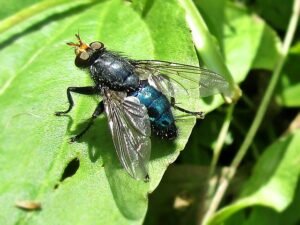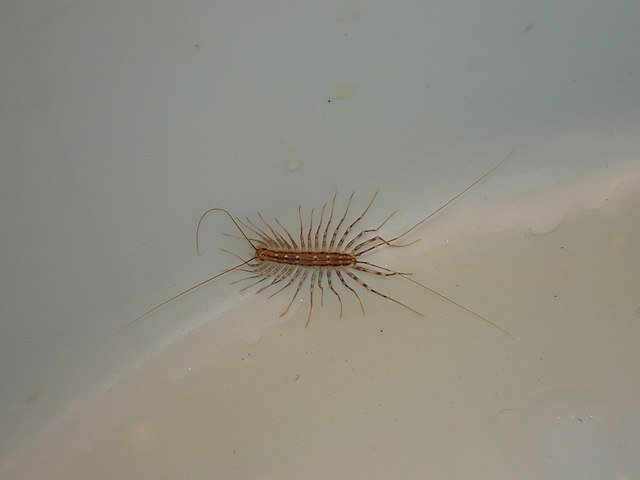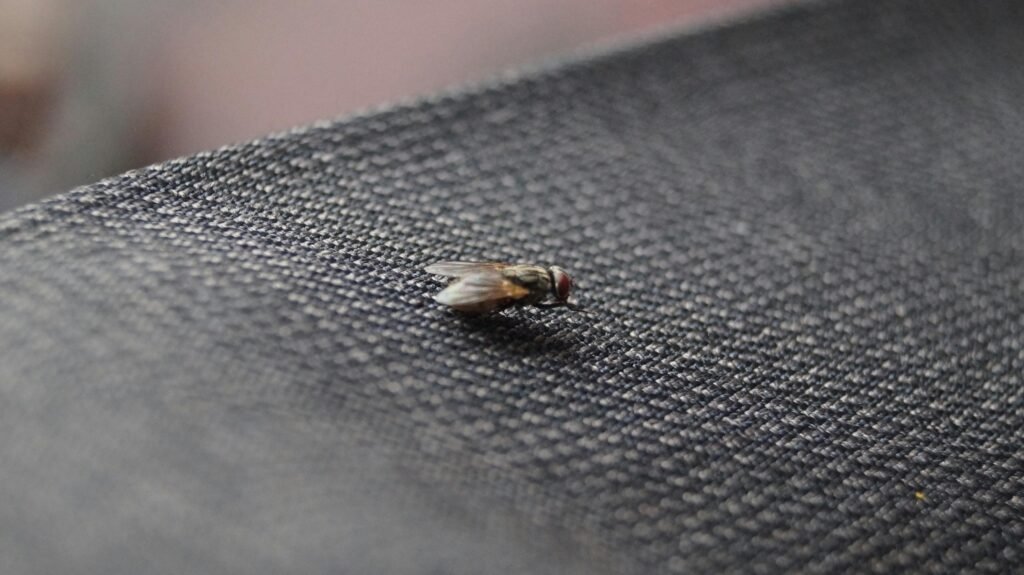Cluster Flies (Pollenia rudis): Identification, Behavior & Control
 Cluster flies (Pollenia rudis) are one of the most frustrating seasonal pests to invade homes and commercial buildings. Unlike common House Flies (Musca domestica), they do not breed in garbage, manure, or food waste. Instead, their larvae parasitize earthworms outdoors, making their biology unusual compared to other nuisance flies.
Cluster flies (Pollenia rudis) are one of the most frustrating seasonal pests to invade homes and commercial buildings. Unlike common House Flies (Musca domestica), they do not breed in garbage, manure, or food waste. Instead, their larvae parasitize earthworms outdoors, making their biology unusual compared to other nuisance flies.
The problem begins in autumn when large numbers of adult cluster flies seek shelter indoors to overwinter. They invade attics, wall voids, and unused rooms, where they remain semi-dormant until spring. Homeowners often discover them in “clusters” around windows or light sources on warm winter days, hence their name.
While cluster flies do not spread disease like Fruit Flies (Drosophila melanogaster), Drain Flies (Psychodidae), or Phorid Flies (Phoridae), they are still a nuisance. Their presence in large numbers is unsightly, and their slow, buzzing flight can become irritating.
This guide explores their identification, biology, behavior, risks, and control, with practical tips for both homeowners and pest management professionals.
Identification
Size: Adults measure 6–10 mm, slightly larger than a common house fly.
Color: Dark gray body with golden-yellow hairs on the thorax, giving a “shimmering” appearance.
Wings: Overlap at rest, unlike house flies.
Movement: Sluggish fliers; tend to cluster in groups on warm surfaces.
Larvae: Parasitoids of earthworms, rarely seen by homeowners.
Field Tip: If you crush a cluster fly, it produces a characteristic “musty” odor, unlike other flies.
Biology and Lifecycle
Cluster flies have a very different lifecycle compared to pantry pests like Cigarette Beetles (Lasioderma serricorne) or fabric pests such as Case-Bearing Clothes Moths (Tinea pellionella).
Eggs: Laid in soil, often near earthworm burrows.
Larvae: Invade earthworms, developing inside their hosts.
Pupae: Form in the soil after larval development.
Adults: Emerge in late summer or early autumn.
Once adults emerge, they feed outdoors but quickly begin searching for overwintering sites, which is when they enter homes. They remain semi-active during winter, becoming more noticeable on warm sunny days when they gather near windows.
Cluster flies typically produce several generations per year in warm climates but only one or two in cooler regions.
Behavior and Seasonal Patterns
Cluster flies are seasonal invaders, with infestations peaking in autumn and spring.
Fall: Adults gather on sunlit walls and rooftops before infiltrating homes.
Winter: They cluster in attics, wall voids, and unused rooms.
Spring: Warmer temperatures awaken them, and they attempt to leave buildings.
Indoors, they do not reproduce or lay eggs. Their only goal is to survive winter. This behavior separates them from House Flies, Fungus Gnats, and Phorid Flies, which actively breed indoors.
Risks and Nuisance Factor
Cluster flies are not dangerous in the way that Mosquitoes (Culicidae) transmit diseases or Cockroaches (Blattodea) contaminate food. However, they present several nuisance issues:
Web accumulation: Their bodies attract spiders such as Cellar Spiders (Pholcidae), leading to secondary infestations.
Dead flies: Large numbers die indoors, attracting scavenging insects like Carpet Beetles (Anthrenus spp.).
Odor: Crushed flies produce a distinctive smell.
Allergy risk: Decaying bodies may contribute to indoor allergens.
Signs of Infestation
Groups of sluggish flies clustering around windows, especially on sunny winter days.
Buzzing noises in attics, crawl spaces, or unused rooms.
Flies appearing in spring before disappearing again.
Outdoor observation of flies basking on south-facing walls in autumn.
Household Control
Managing cluster flies indoors requires a multi-step approach:
Exclusion: Seal cracks, gaps, and vents before autumn. Use fine mesh screens.
Vacuuming: Remove sluggish flies as they appear.
Lighting: Limit outdoor lights that attract flies to structures.
Cleaning: Regular removal of dead flies prevents secondary pests.
DIY traps: Light traps can capture emerging flies in attics or unused rooms.
Unlike Fruit Flies or Fungus Gnats, eliminating food sources is not effective, since cluster flies do not feed indoors.Professional and Long-Term Control
For heavy infestations, pest control companies may recommend:
Residual insecticides: Applied to exterior walls and entry points before overwintering season.
Dust treatments: For wall voids or attics where flies gather.
Integrated Pest Management (IPM): Focusing on exclusion and structural maintenance.
Monitoring: Using fly lights in commercial spaces to track populations.
Chemical treatment is most effective when applied in late summer or early autumn, before the flies move indoors. Once inside, physical removal is usually the only practical option.
Comparative Context
Cluster flies often get confused with:
House Flies (Musca domestica): Faster, associated with food waste.
Blow Flies (Calliphoridae): Metallic green/blue, breed in carrion.
Stable Flies (Stomoxys calcitrans): Blood-feeding pests.
Final Thoughts
Cluster flies (Pollenia rudis) are not your typical household pest. Unlike Drain Flies, Fruit Flies, or Phorid Flies, they are not indicators of sanitation issues indoors. Their life cycle is tied to earthworms in the soil, which makes their seasonal invasions more about weather and building structure than about food sources.
For homeowners, their greatest annoyance lies in their sheer numbers and persistence during winter. They do not bite, spread disease, or reproduce inside homes. Still, the buzzing clusters near windows and the accumulation of dead flies can be frustrating and unsightly.
The most effective strategy is prevention—sealing entry points before autumn. Once indoors, physical removal through vacuuming and light traps is usually sufficient. Professional pest control is rarely required unless infestations are severe, but exterior treatments can help reduce numbers in problem-prone buildings.
Ultimately, cluster flies are a reminder of how even the most unusual insects find ways to coexist with humans. While they are not dangerous, understanding their biology and behavior helps in managing them effectively.
Frequently Asked Questions (FAQ)
Q: Do cluster flies bite humans?
A: No. Cluster flies do not bite, sting, or feed on blood. They are nuisance pests only.
Q: Why do cluster flies gather in groups?
A: Their overwintering instinct drives them to cluster in warm, protected areas, often attics, wall voids, or sunny windows.
Q: Do cluster flies reproduce inside homes?
A: No. Their larvae only develop inside earthworms outdoors. Indoors, they simply overwinter as adults.
Q: How long do cluster flies live?
A: Adults can live for several months, especially when overwintering inside buildings.
Q: Can pesticides eliminate cluster flies indoors?
A: Once inside, pesticides have limited impact. Prevention (sealing cracks, treating exterior walls in autumn) is more effective than indoor spraying.
Q: Are cluster flies dangerous for pets?
A: No. They do not transmit diseases to pets or humans.
Disclaimer
This article is for informational purposes only. Pest control laws and approved chemicals vary by country. For best results and legal safety, we strongly recommend contacting a licensed pest control professional in your local area. Always make sure that the pest control technician is properly certified or licensed, depending on your country’s regulations. It’s important to confirm that they only use approved products and apply them exactly as instructed on the product label. In most places in Europe, UK, or USA, following label directions is not just best practice—it’s the law.
Author
Nasos Iliopoulos
MSc Agronomist & Certified Pest Control Expert
Scientific Director, Advance Services (Athens, Greece)
Licensed Pest Control Business – Ministry of Rural Development & Food (GR)
References
Penn State Extension – Cluster Flies
Wikipedia – Cluster Flies
The sluggish, clustering behavior of Pollenia rudis makes them distinct.


